Ultimate Beijing Travel Guide and 3-Day Itinerary
Beijing, the capital of China, is located in the northern part of the country and has a permanent population of approximately 21.84 million, which is nearly equivalent to Australia’s population of 26 million. It is home to the headquarters of renowned companies like TikTok and Xiaomi.
Beijing experiences four distinct seasons, with hot summers (30-35°C) and cold winters (0-5°C). The best months for tourism are May, September, and October.
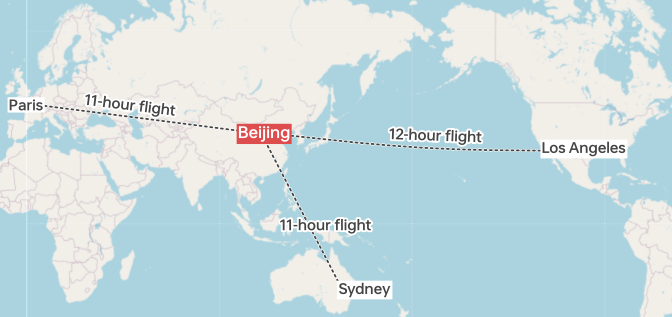
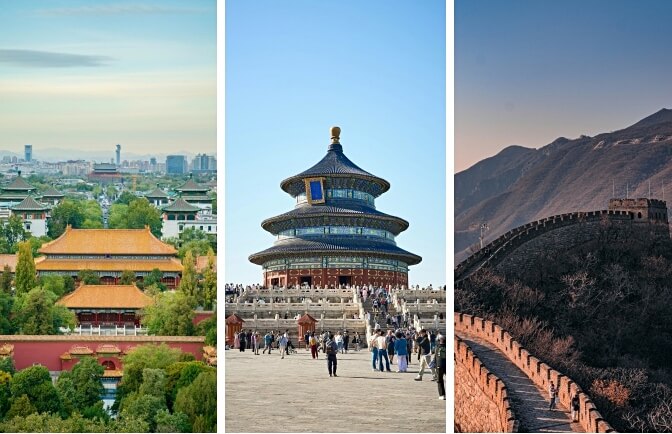 by Vida Huang | Isaac Chou | Dana Andreea Gheorghe
by Vida Huang | Isaac Chou | Dana Andreea Gheorghe
Airport Transportation
Beijing has two airports. Click on the image below to enlarge it.
The airports have clear English signage. You can purchase tickets for the Airport Express at automated ticket machines or staffed counters. Inside the train carriages, there are English signs and announcements, so there’s no need to worry about language barriers.
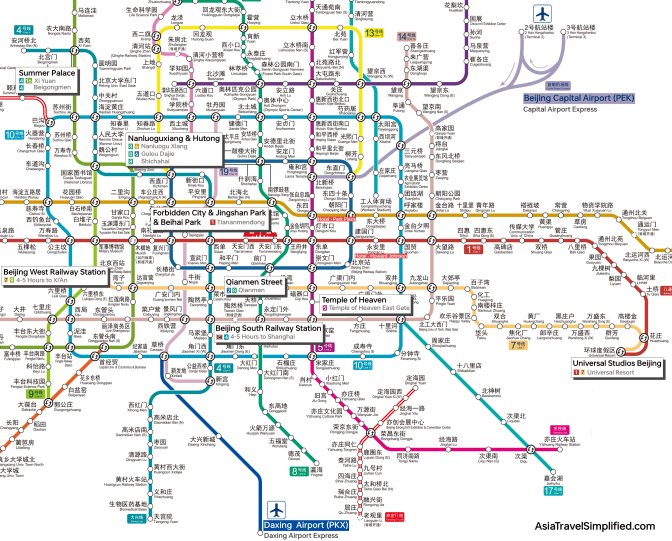
Beijing Capital International Airport (PEK)
Located about 30 km from the city center, some of the facilities may seem outdated, and you might need to take a shuttle bus to your terminal instead of using a jet bridge. Here’s how to get to the city:
Capital Airport Express
Fare: 28 RMB. Timetable can be found here.
Stops include: T2 Terminal, T3 Terminal, Sanyuanqiao, Dongzhimen, and Beixinqiao.
Taxi
Follow the signs to the taxi line. The trip takes about 1–1.5 hours and costs 60–100 RMB (depending on traffic). Using Didi (China’s ride-hailing app) is cheaper, but the pick-up area can be chaotic, and you might have trouble finding your driver.
Nearby Hotels
Hilton Beijing Capital Airport Free shuttle service available
Watch: Full Trip Beijing Airport to Downtown Beijing
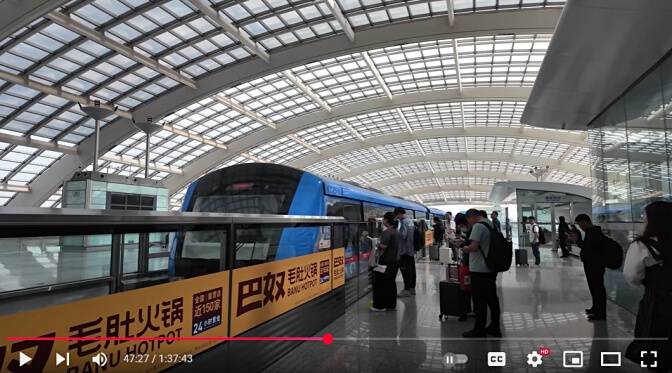
Beijing Daxing International Airport (PKX)
Located about 55 km from the city center, this airport was completed in 2019. The facilities are newer, and the overall experience is more pleasant. Here’s how to get to the city:
Daxing Airport Express
Fare: 35 RMB. The timetable can be found here.
Stops include: Daxing Airport, Daxing Xincheng, and Caoqiao
Taxi
Follow the signs to the taxi line. The trip takes about 1.5 hours and costs 150–200 RMB (depending on traffic). Using Didi is cheaper, but the pick-up area can be confusing, and you might have trouble finding your driver.
Nearby Hotels
Mumian Beijing Daxing International Airport The hotel is inside the airport
Hilton Garden Inn Beijing Daxing Airport Free shuttle service available
Watch: Beijing Daxing (PKX) Airport International Arrivals Procedure and Transfer onto Beijing Subway
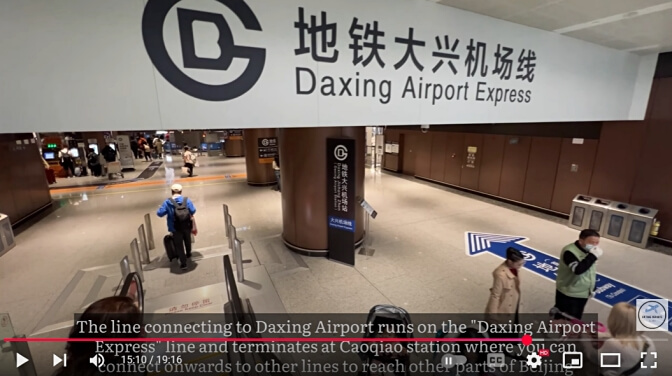
Recommended Hotels
Howard Johnson Paragon Hotel Beijing Central
The location is excellent—right next to the subway station (Beijing Railway Station – Exit B). The Forbidden City and nearby attractions are within a 15-minute drive, and it’s just a 10-minute walk to Wangfujing Shopping Street, which offers plenty of dining options.
However, keep in mind that Beijing Railway Station is one of the city’s major transport hubs, so the area is always crowded with tourists.
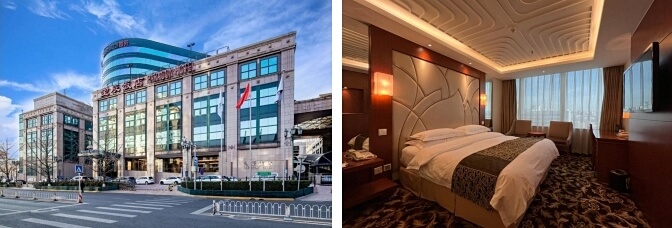
Holiday Inn Express Beijing Dongzhimen
Highly rated—the Forbidden City and nearby attractions are within a 20-minute drive, and the popular Sanlitun shopping district is just 1.2 km away (about a 17-minute walk).
The only drawback is that the nearest subway station (Dongzhimen Station) is also a 17-minute walk away, so this hotel is best suited for visitors who plan to use Didi.

3-Day Itinerary and Map
Day 1: Visit the 1.The Palace Museum in the morning, then head to 2.Jingshan Park and 3.Beihai Park in the afternoon.
Day 2: Visit the 4.Temple of Heaven in the morning, then explore 5.Nanluoguxiang in the afternoon.
Day 3:Visit the 6.Mutianyu Great Wall in the morning, then stroll around 7.Qianmen Street in the evening.
Map:
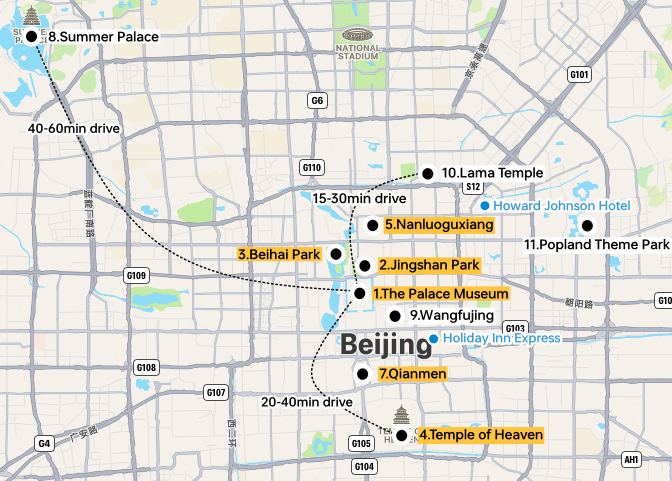

Getting Around Beijing
Navigation Apps
If you’re using an iPhone, you can navigate with Apple Maps. For Android users, you can download the “Beijing Map” app.
Walking
If your destination is nearby, walking is a great option. Beijing is very safe, both day and night. However, be extra cautious when crossing the street—watch out for electric scooters. They’re fast, quiet, and often the drivers don’t follow traffic rules. (In my opinion, this is one of the biggest downsides of Beijing.)
Taxis
In most cases, I recommend using Didi (it’s cheaper, the cars are newer, and the drivers are usually friendlier). However, in busy areas like airports and train stations, it can be difficult for Didi drivers to find you using phone GPS alone. Locals usually call the driver directly to figure out the exact location.
Cost: You can use Didi to estimate the fare. Taxis are generally more expensive than Didi, but not more than double the price.
Tips:
Always choose taxis from the official queue and avoid drivers who approach you offering rides.
When you get into the taxi, show the driver your hotel’s address in Chinese.
All taxis use a meter. Before getting out, you can pay by scanning the driver’s QR code with Alipay.
No tipping is required for taxi drivers.
If you think the fare is unreasonable, there’s no need to argue with the driver. Take note of the license plate number (or, if you forget, remember the time you got out of the taxi) and ask your hotel staff to help you file a complaint. If the driver has taken a longer route to overcharge you, you’ll receive a refund, and the driver will be suspended for a week. Beijing has a supervisory service called the Mayor’s Hotline that oversees both government and business services. All complaints are responded to.
Didi
Didi is very convenient. You can order a ride directly through the Didi option in Alipay, and you don’t need a Chinese phone number.
Tips:
After getting into the car, the driver may show you their phone with a four-digit number (this is either the last four digits of your phone number or the virtual number assigned to your eSIM). This is to confirm you are the correct passenger. (When you use Didi, the driver can see the last four digits of your phone number. If you use another ride-hailing platform, the driver might ask for the last two or four digits of your number and enter them into the app before the fare starts, signaling that the trip officially begins.)
If you take a highway, the toll fee may be automatically added to your final bill. Alternatively, the driver might stop at a toll station and have you scan the attendant’s Alipay QR code for payment (you can simply open your Alipay app and hand your phone to the driver — rest assured this is completely safe). Both methods are standard practices and depend on the driver’s preference.
If you can’t locate your driver or change your mind, you may cancel the ride, though a 3 RMB cancellation fee will apply. Therefore, we recommend waiting at clearly identifiable locations like bus stops or building entrances to help your driver find you easily.
Watch: How to DIDI in China 2025. Step by step
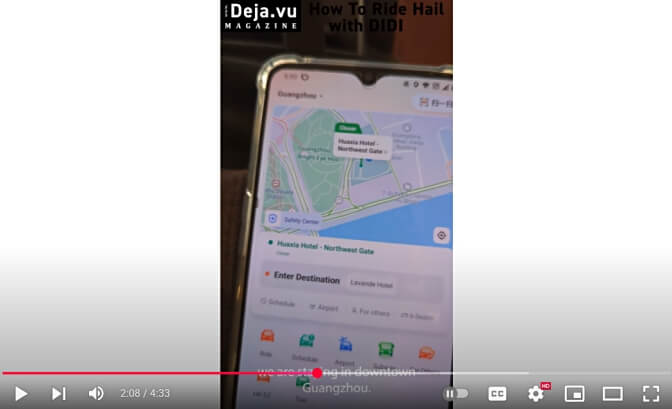
Subway
Beijing has 27 subway lines operating from 5 AM to midnight, covering most tourist attractions. Stations have clear English signage, and each station has restrooms (after entering the paid area).
Cost: 3 to 10 RMB, depending on the distance traveled.
Route Map and Timetable: bjsubway.com
Ticket Purchase: Although many travel videos by YouTubers show purchasing tickets at ticket counters or automated machines, in reality, the Beijing Subway fully supports Apple Pay, and you can also use your Visa or Mastercard credit card for tap-and-go entry at the gates.
Tips:
- Avoid using the subway during rush hours (7:30 AM - 9:00 AM and 5:00 PM - 6:30 PM). If you’ve seen videos of rush hour in Tokyo, yes, Beijing can be just as crowded.
- It’s also not recommended to use the subway from mid-July to mid-August. During this period, the subway is packed with tourists from other parts of China. Locals often complain on social media about being late because they can’t get off the train, or being blocked by crowds of tourists as soon as they exit the train.

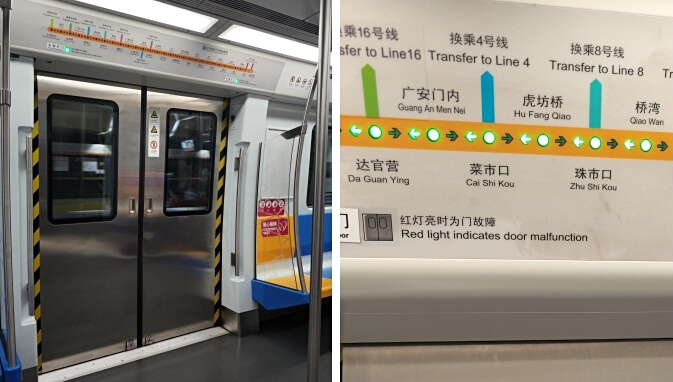
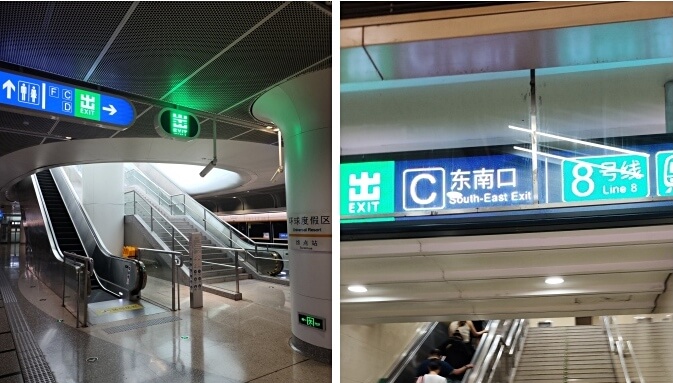
Watch: Riding the Beijing Subway: Wangfujing to Temple of Heaven
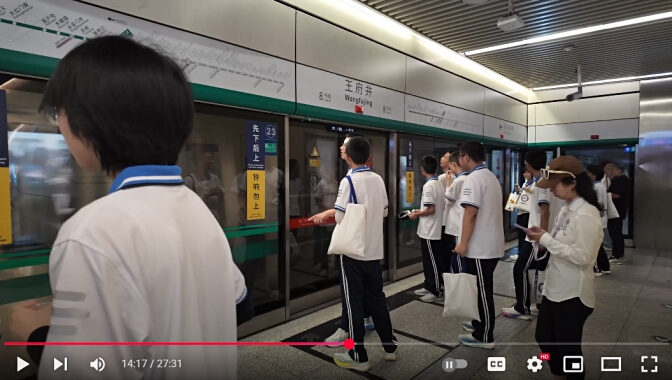
Buses
Buses in Beijing are inexpensive, well-maintained, and air-conditioned. However, young locals and tourists from other parts of China rarely use them. The bus routes are designed for local residents, with many stops, and infrequent service outside of rush hours, doubling the travel time compared to the subway. Additionally, bus stops lack clear English signage, making them less suitable for first-time foreign visitors to China.
Top Attractions in Beijing
1. The Palace Museum (Forbidden City)
The Forbidden City is 961 meters long and 753 meters wide. Completed in 1420, it was home to 24 emperors. In 1912, the last emperor of the Qing Dynasty abdicated, marking the end of China’s imperial rule. In 1925, the Forbidden City became the Palace Museum and opened to the public. Today, it is one of Beijing’s most popular tourist attractions.
Hours:
- Closed on Mondays
- April 1–Oct 31, 8:30 AM - 5:00 PM
- Nov 1–Mar 31, 8:30 AM - 4:30 PM
Admission:
- 60 RMB (Apr–Oct), 40 RMB (Nov–Mar)
- Tickets for the Palace Museum are in high demand, so set a reminder to book your tickets on the official website exactly 7 days before your visit at 8:00 PM (Beijing time). Tickets usually sell out within 30 minutes.
- If you’re unable to book tickets online, you can go directly to the ticket window at the Palace Museum. Show your passport, and the staff will likely sell you a same-day ticket. This service is available only to foreign tourists, and the number of tickets is limited, so it’s best to go early.
- Children under 6 enter for free, seniors over 60 get half-price tickets, and students aged 7-18 can enter for 20 RMB with a student ID, regardless of nationality.
- The Treasure Gallery and the Gallery of Clocks inside the Forbidden City each have a separate entry fee of 10 RMB. These galleries are worth visiting, and if you couldn’t book tickets online, you can purchase them on-site.
Getting There:
- Take Subway Line 8 to Jinyu Hutong Station, exit at Gate C, and walk 13 minutes to the Donghuamen Gate of the Forbidden City (this gate is exit-only, no entry). Then, follow the signs and walk another 10 minutes along the wall to reach the Meridian Gate (Wumen Gate), the main entrance to the Forbidden City.
- Alternatively, you can use a ride-hailing service like Didi and set the destination to ‘Donghuamen.’ The app will notify you of traffic control nearby and suggest changing to ‘East side of Beichizi Street/Nachizi Street.’ Accept the suggestion, then walk for 5 minutes after getting off.
- If you’d like to visit Tiananmen Square as well, take the subway to Tian’anmendong Station. However, be prepared for long queues, and note that entering Tiananmen Square requires a reservation. If you speak Chinese, you can make a free reservation via WeChat. For convenience, I recommend using the Tiananmen Square Registration Service. There are three security checks to pass before entering, and during the summer, you might have to wait for up to an hour. After visiting Tiananmen Square, you can walk directly to the Forbidden City entrance.
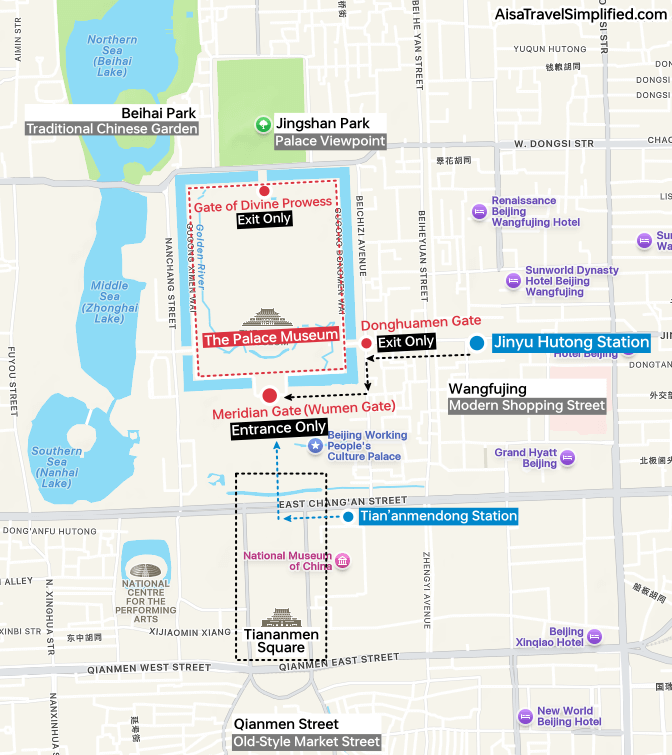
Recommended Visit Time: 2-3 Hours
How to visit:
- You can visit at your own pace, but note that the Treasure Gallery and the Gallery of Clocks stop admitting visitors at 4:10 PM.
- There are restaurants inside the Palace Museum, and you’re allowed to bring your own food and drinks.

Official Site: dpm.org.cn
Watch: Forbidden City Walkthrough 2025
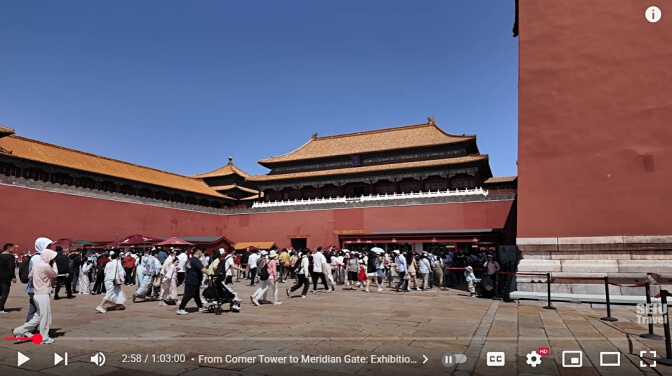

Watch: What You Need to Know Before Visiting the Forbidden City
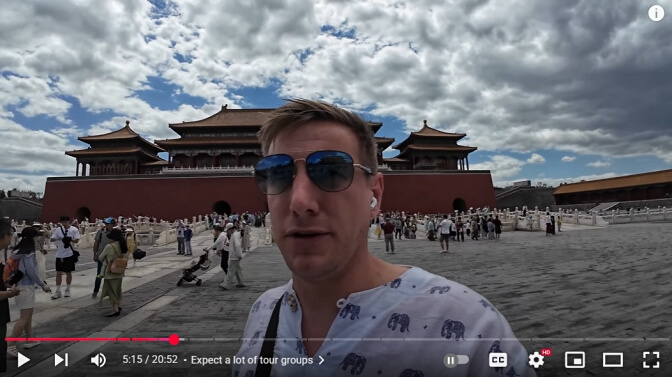
Photo Highlights:
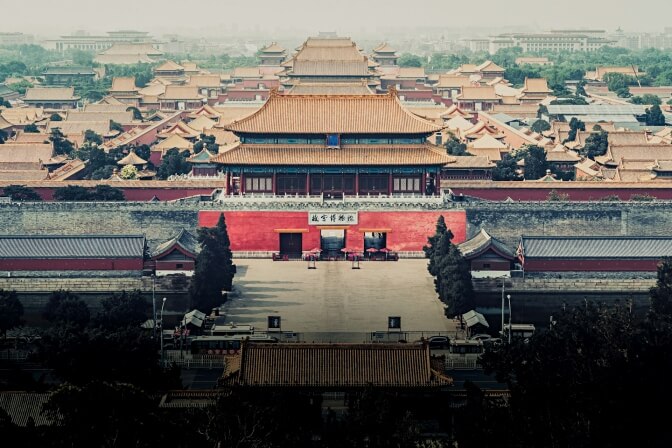
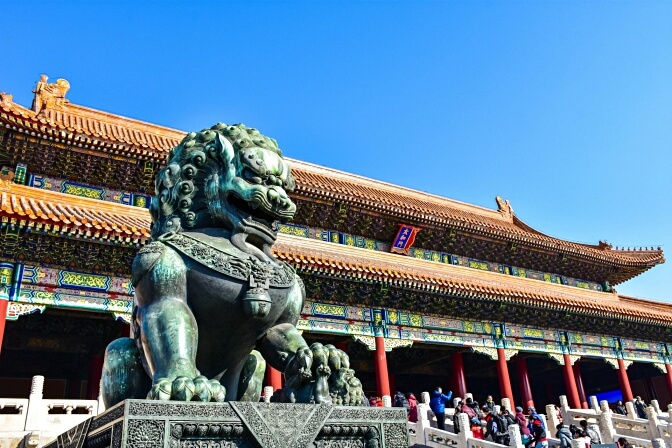
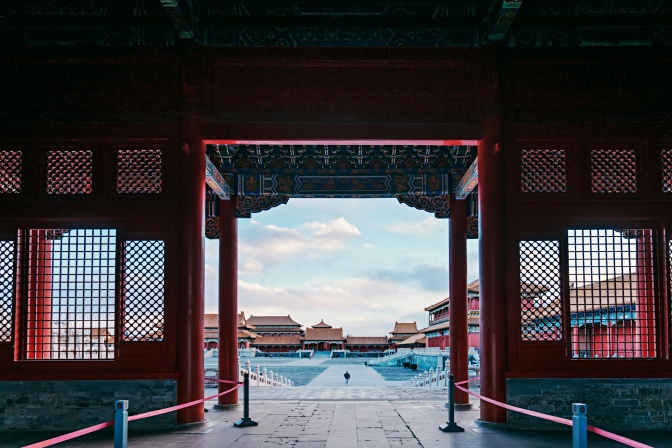 by ZQ Lee | Lan Lin | zhang kaiyv
by ZQ Lee | Lan Lin | zhang kaiyv
2. Jingshan Park
Jingshan Park is located on the north side of the Forbidden City and offers the best view of the palace.
Hours: April 1–Oct 31, 6:30 AM–9:00 PM; Nov 1–Mar 31, 6:30 AM–8:00 PM
Admission: 10 RMB, on-site ticket purchase, no reservation required
Getting There:
After exiting the Forbidden City’s Gate of Divine Prowess (Shenwu Gate / 神武门), take the underground passage to cross the street, and you will find the south gate of Jingshan Park directly opposite.
Recommended Visit Time: 30 Minutes
Watch: See the Forbidden City for free at Jingshan Park
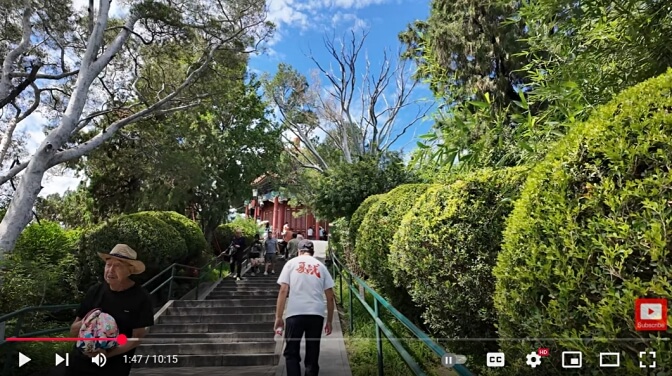
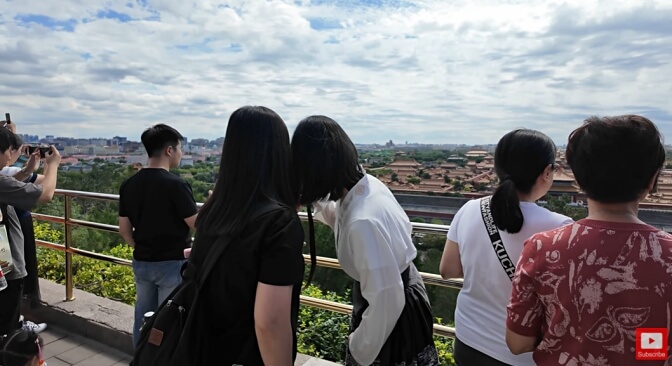
Photo Highlights:
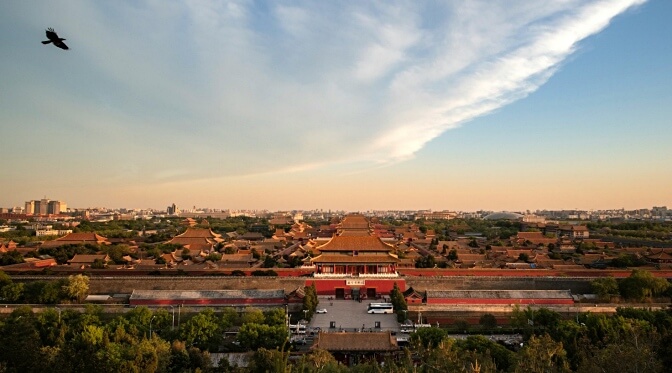 by Arvin Yuan
by Arvin Yuan
3. Beihai Park
Beihai Park was built in 1166, and the White Pagoda within the park is one of Beijing’s landmark attractions. Beihai Park is much smaller than the Summer Palace, but locals enjoy boating here, while visitors from other cities in China like to take photos in traditional costumes.
Hours: April 1–Oct 31, 6:00 AM–9:00 PM; Nov 1–Mar 31, 6:30 AM–8:00 PM
Admission: 10 RMB (tickets can be purchased on-site, no reservation required)
Getting There:
Exit from the west gate of Jingshan Park and walk 250 meters to reach the east gate of Beihai Park.
Recommended Visit Time: 1.5 Hours
How to visit:
You can explore at your leisure on foot, or follow the sightseeing route shown on the map below. This route includes a boat ride costing 20 RMB per person (There are multiple boat routes. Please confirm that your destination is Wulongting (五龙亭)). Finally, exit from the north gate of Beihai Park and walk 500 meters to Beihaibei Station (北海北站) on Line 6 of the subway.
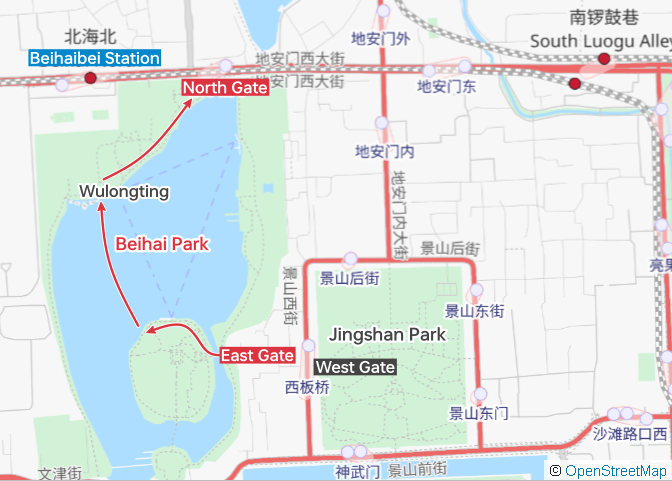
Watch: A Quiet afternoon in Beihai Park | Slow Travel in Beijing


4. Temple of Heaven
The Temple of Heaven is the largest ancient complex in the world dedicated to worshiping the heavens. Built in 1420, it was where ancient emperors conducted ceremonies to pray for good harvests and rain. The Temple of Heaven is a must-visit attraction in Beijing, and seeing it in person is far more impressive than any photo can capture.
Hours: April 1–Oct 31, 6:00 AM–10:00 PM; Nov 1–Mar 31, 6:30 AM–10:00 PM
Admission:
- 34 RMB (Apr–Oct), 28 RMB (Nov–Mar)
- The ticket price includes both the entrance fee and the combination Ticket for the Hall of Prayer for Good Harvests, the most important site within the park.
- Foreign visitors can buy tickets at the entrance without a reservation.
- Children under 6 enter for free; those under 18 pay half price. Visitors over 60 get in for free, regardless of nationality.
Getting There:
Take the subway to Temple of Heaven East Gate(Tian’anmendong Station) and exit at Exit A2.
Recommended Visit Time: 1 Hours
How to visit:
It’s recommended to enter the park through the East Gate, visit the most iconic area (the Hall of Prayer for Good Harvests and its surroundings), and then exit through the East Gate. The Temple of Heaven has four entrances, but the other gates are farther from the subway station.
Watch: 这里是北京 | 天坛
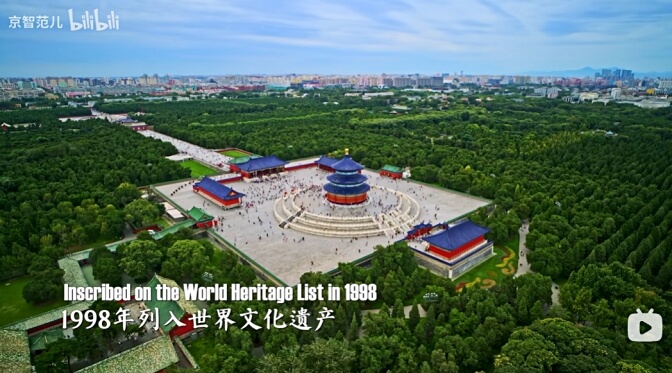
Watch: Inside Beijing’s Temple of Heaven
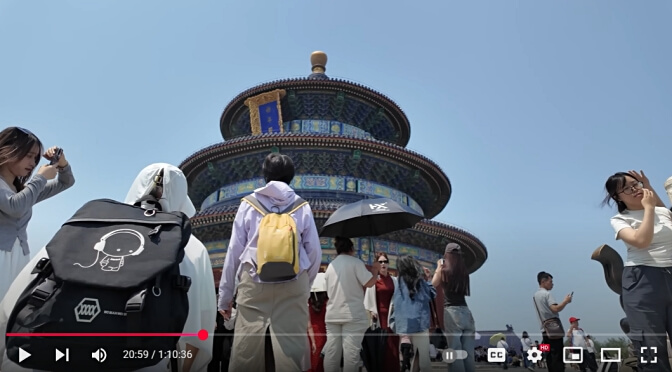
Photo Highlights:
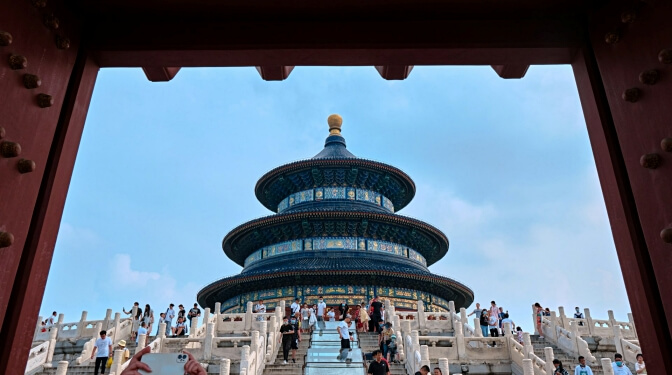 by Willem Chan
by Willem Chan
5. Nanluoguxiang & Hutong
You can spend 2-3 hours exploring the hutongs and visiting the commercial streets within the hutong area.

1. Nanluoguxiang
Nanluoguxiang is a 787-meter-long street located in a traditional hutong area. It was transformed into a pedestrian shopping street around 2008. Unlike Qianmen Street, the shops here mainly cater to younger visitors, making it a better spot for a leisurely stroll.
Recommended Visit Time: 15 - 30 Minutes
Getting There: Take Subway Line 6 or Line 8 to Nanluogu Xiang Station and use Exit E.
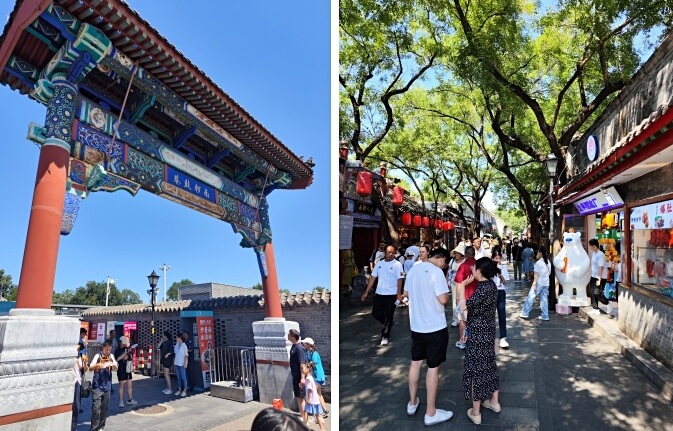
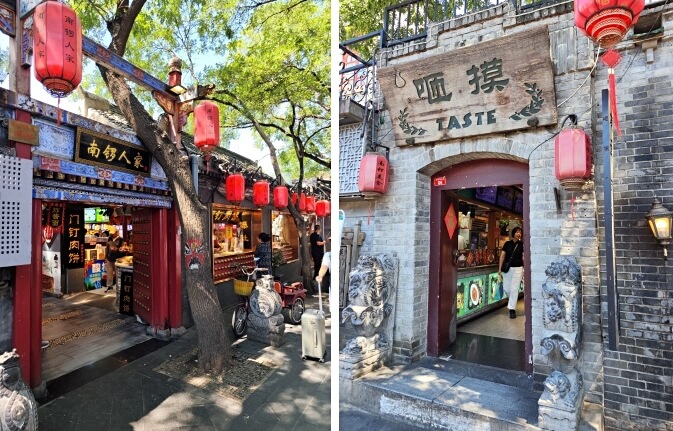


2. Gulou
Gulou, also known as the Drum Tower, stands 46.7 meters tall and was historically used to announce the time. On clear days, you can buy a ticket to go inside. It offers a great spot for a panoramic view of the surrounding streets.
Hours:
April 1 - October 31 9:30 AM - 5:30 PM
November 1 - March 31 9:30 AM - 4:30 PM
Closed on Mondays.
Admission: 20 RMB.
Seniors over 60 and university students over 18 get half-price tickets. Children under 18 can enter for free. No reservation needed; tickets can be purchased on-site.
Recommended Visit Time: 30 Minutes
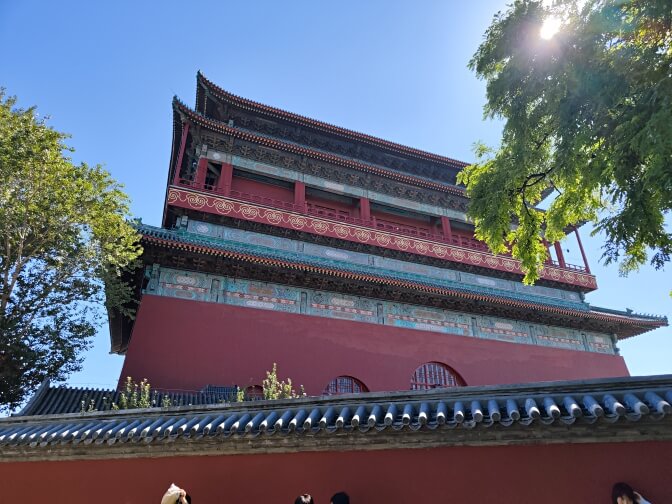

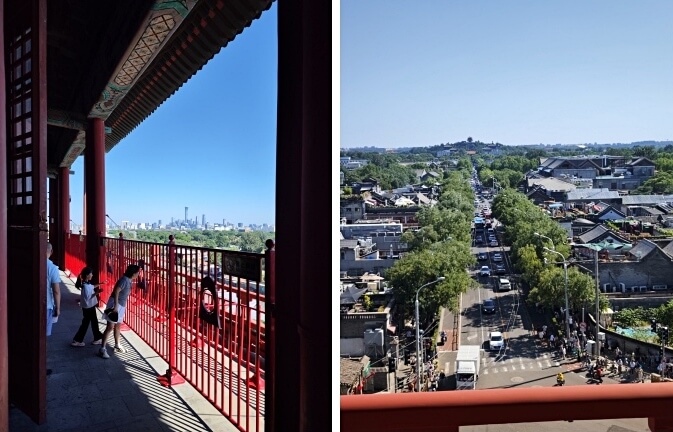
3. Yandaixiejie
Yandaixiejie is 232 meters long and about 4 meters wide, connecting Gulou Street and Shichahai. It’s like a smaller version of Nanluoguxiang.

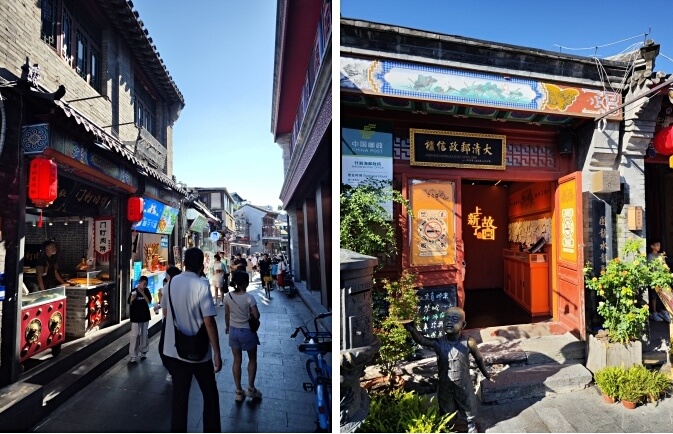
4. Shichahai
Shichahai is a historic area with lakes, willow trees, hutongs, bars, and restaurants. It’s a popular spot for locals in Beijing to take a stroll or go boating on weekend evenings.
Recommended Visit Time: 15 Minutes - 2 Hours
Getting There: Take Subway Line 8 to Shichahai Station and use Exit A1.
- The center of Shichahai is Yinding Bridge (银锭桥). You can take a short walk around the area or stroll around the entire lake.
- A 4-person pedal boat costs 180 RMB per hour with a 600 RMB deposit, while a 4-person electric boat costs 240 RMB per hour. Larger boats are also available, with instructions in both Chinese and English on-site.
- A rickshaw ride costs about 150 RMB for 30 minutes (for 2 adults). The driver will give a brief explanation of the surrounding buildings, but they only speak Chinese..
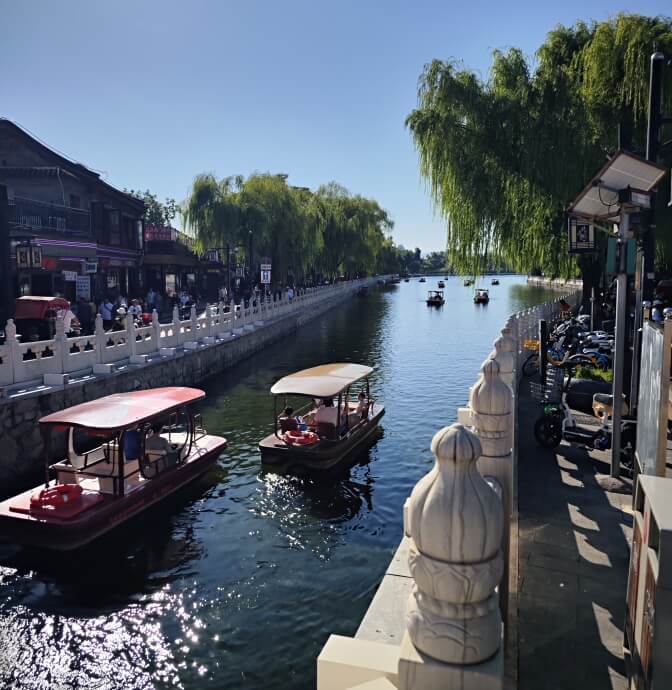
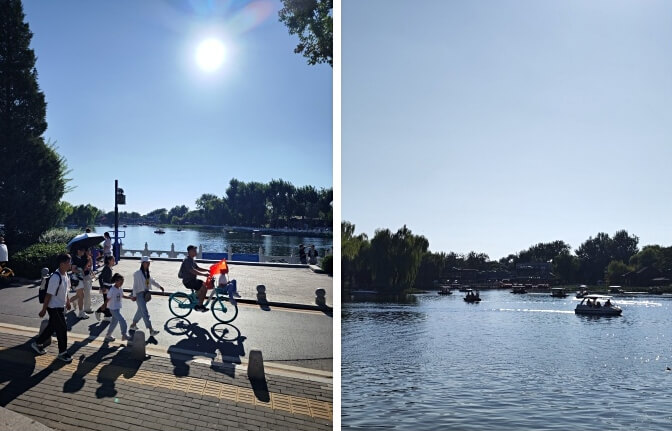
5. Chijian Huode Zhenjun Temple
This small Taoist temple, dedicated to several deities, has a history of around 1,400 years. Despite its size, the temple offers a serene and sacred atmosphere, providing a sharp contrast to the lively, commercial vibe of the surrounding Shichahai area. It’s a hidden gem worth visiting.
Hours: 9:00 AM - 5:00 PM
Admission: Free
Recommended Visit Time: 5 - 10 Minutes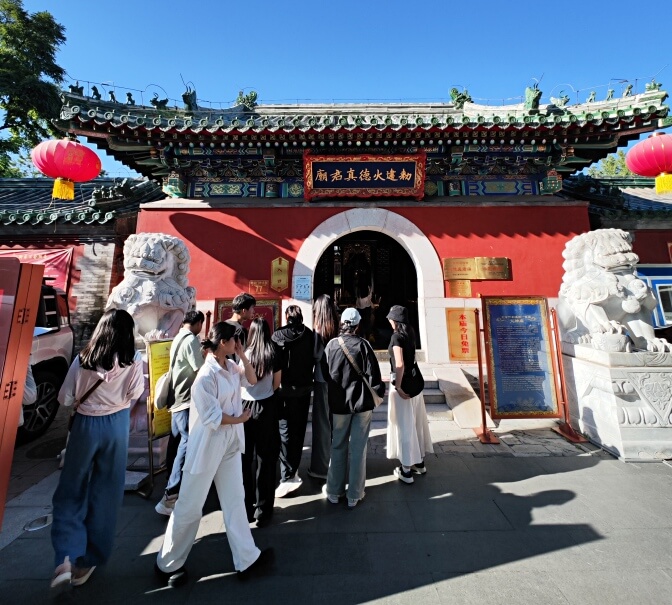

6. Mutianyu Great Wall
The Great Wall is one of China’s most iconic landmarks, with a history of over 2,000 years. Due to its complex terrain and the fact that it was built at different times, the Great Wall isn’t a continuous structure but is made up of several sections. The two most popular sections for visitors are the Mutianyu Great Wall (accessible only by taxi or long-distance bus, about 1.5 to 2 hours each way, but it’s less crowded, offers great views, and even has a toboggan ride) and the Badaling Great Wall (reachable by high-speed train in just 30 minutes, though it tends to be more crowded). This guide focuses on the Mutianyu Great Wall.
Hours: 7:00 AM - 6:00 PM
Admission: 40 RMB. No reservation needed; tickets can be purchased on-site.
Getting There:
- Mutianyu is about 75 kilometers from downtown Beijing, which takes around 1.5 to 2 hours by car.
- You can join a day tour, such as: Mutianyu Great Wall Tours with Options
- If you prefer not to join a group tour, you can take a Didi (ride-hailing service). A sedan (seats up to 4 passengers) costs between 200 and 250 RMB one-way, depending on traffic. You can easily get a car both ways without needing to book in advance. It’s best to leave downtown Beijing before 7:00 AM to avoid large crowds. The highway toll is about 15 RMB. Some drivers will charge it directly through the system, while others may ask you to pay it at the toll station by scanning a QR code. Both methods are normal. The parking lot is about 3 kilometers from the Great Wall entrance. You can buy a shuttle bus ticket for 15 RMB round-trip on-site.
- Locals usually take the direct bus from Qianmen, but the bus stops are not fixed and simply pull over by the roadside. Since there are no English signs, this option may not be very foreigner-friendly.
Recommended Visit Time: 3-5 Hours
How to visit: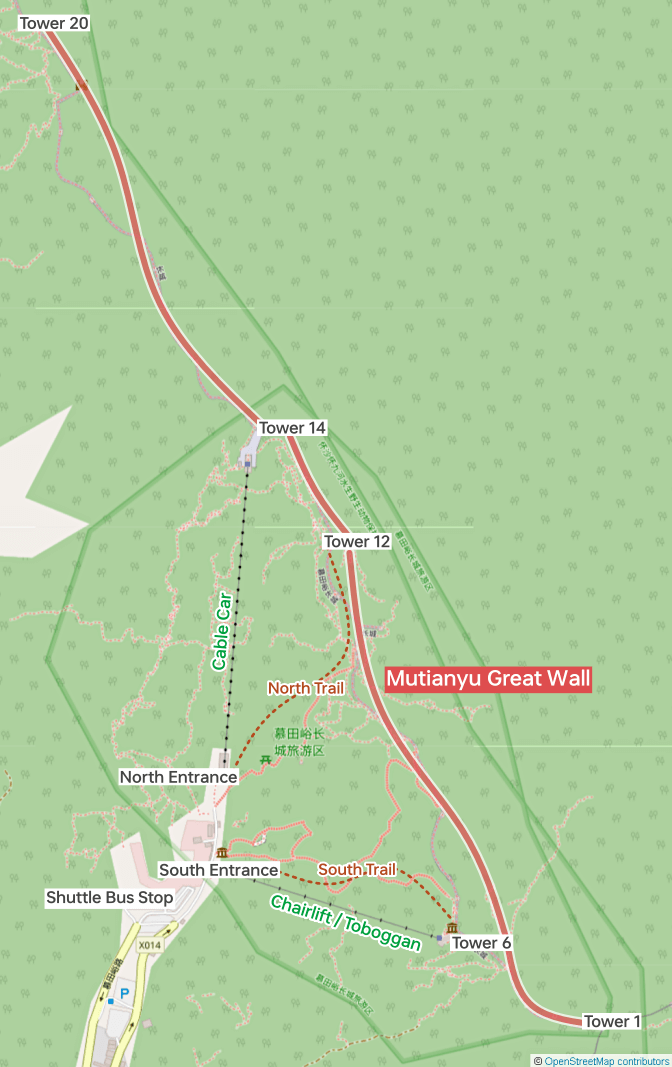
2-Hour Hiking Route:
Start at the South Entrance > Tower No. 6 > Tower No. 12 > Descend > Exit at the North Entrance. Most people can complete this route easily.
4-Hour Hiking Route:
Start at the South Entrance > Tower No. 6 > Tower No. 12 > Tower No. 20 (the highest point of the Mutianyu Great Wall) > Tower No. 12 > Descend > Exit at the North Entrance. This route requires good physical fitness.
The Easiest Route:
Enter from the North Entrance and take the cable car (about 5 minutes) to Tower No. 14 at the top (each cable car holds up to 8 people, with a one-way fare of 100 RMB per person; tickets available on-site) > Walk from Tower No. 14 to Tower No. 6 (about 1 to 1.5 hours) > Ride the toboggan down the mountain, which takes only 10 minutes (but if it’s crowded, you may have to wait 30 minutes to 2 hours; if the wait is too long, you can take the chairlift down or walk down in about 25 minutes).
Watch: 航拍层林浸染的慕田峪长城
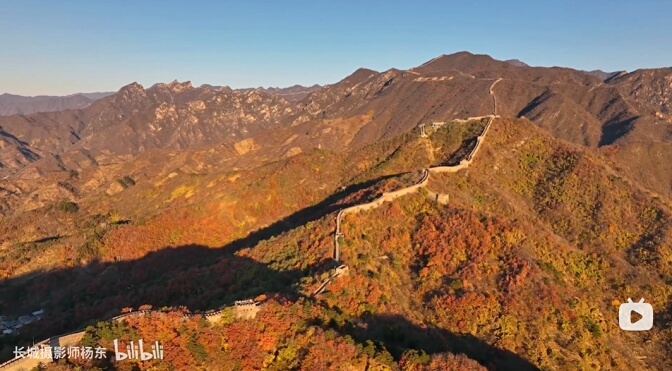
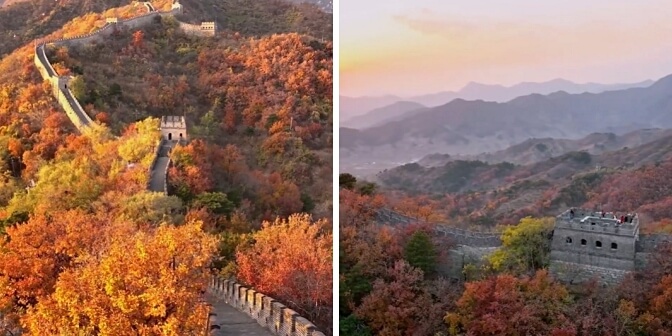
Watch: Walking the Great Wall of China

Watch: Great Wall of China Mutianyu Toboggan
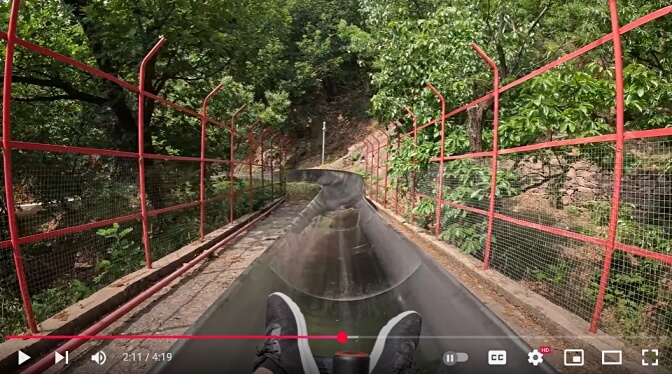
Photo Highlights:
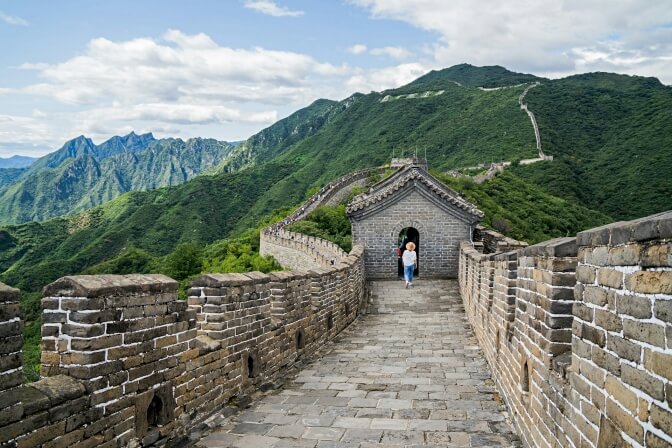 by Victoriano Izquierdo
by Victoriano Izquierdo
7. Qianmen Street
Qianmen Street was once the commercial center of Beijing over 100 years ago. Today, it is a hub for well-known, traditional shops and a popular tourist destination.
Most of the shoppers on Qianmen Street are tourists from other parts of China, and local Beijingers rarely visit. This is partly because Beijing’s summers are hot, winters are cold, and spring is windy, so locals prefer shopping in malls. However, some older locals still come here to buy tea or pickles, as they believe these traditional shops offer the most authentic flavors.
That said, Qianmen Street has a unique charm and strong Beijing character, making it definitely worth a visit. Be sure to try the jasmine-flavored ice cream at Wuyutai, a famous tea shop in Beijing. It’s only 10 RMB!
Getting There: Take Subway Line 2 or Line 8 to Qianmen Station. Use Exit C.
Recommended Visit Time: 1 Hour
How to visit:
1. Qianmen Street

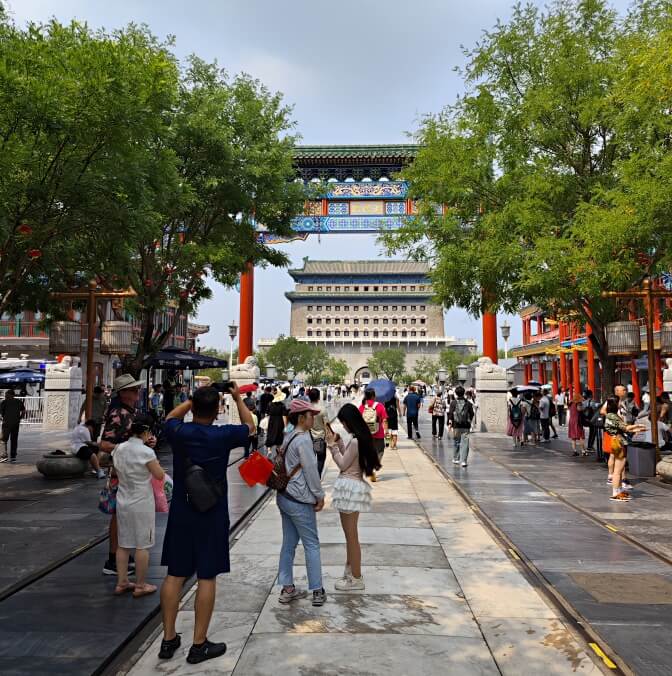
2. Dashilan Street

3. Pageone Bookstore
You can buy souvenirs here, and the third floor offers a great spot for taking photos of the nearby Zhengyangmen Arrow Tower.
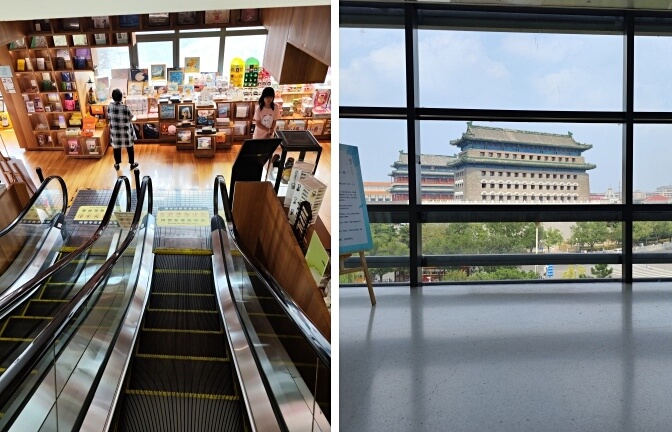
Watch: Beijing’s Most Famous Walking Street at Night 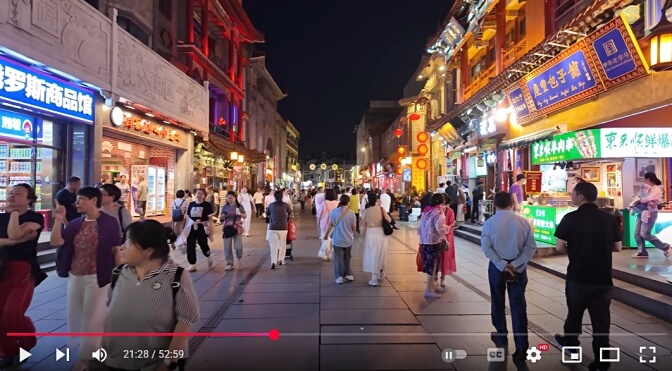
Optional Attractions in Beijing
8. Summer Palace
The Summer Palace is the largest imperial garden still preserved in China. It was originally expanded from an older garden to celebrate the emperor’s mother’s 60th birthday and was listed as a UNESCO World Heritage Site in 1998. Because the Summer Palace is located about an hour’s drive from the city center—and you may already feel a bit tired of traditional Chinese architecture after visiting the Temple of Heaven, the Forbidden City, and Beihai Park—I’ve listed it as an optional attraction.
Hours: April 1–Oct 31, 6:00 AM–8:00 PM; Nov 1–Mar 31, 6:30 AM–7:00 PM
Admission: 30 RMB (Apr–Oct), 20 RMB (Nov–Mar)
- Only a basic entrance ticket is needed—no need to buy a combined ticket.
- Foreign visitors can buy tickets at the entrance without a reservation.
- Children under 6 enter for free; those under 18 pay half price. Visitors over 60 get in for free, regardless of nationality.
Getting There:
The easiest way to get there is by using Didi. Set your destination in the app as “Summer Palace Xinjiangongmen.” If you want to save money, you can take subway Line 16 to Xiyuan Station, then take a short ride from there.
Recommended Visit Time: 2-3 Hours
How to visit:
- Route A (blue on the map): A walking route that takes about 3 hours. You’ll exit through the North Ruyi Gate and can either take a Didi ride to your next stop or walk about 800 meters to Beigongmen Subway Station.
- Route B (red on the map): Takes about 2.5 hours and includes a boat ride (40 RMB per person). There are several boat routes—make sure your destination is Shifang (石舫). You’ll exit through the East Gate (Donggongmen) and can either take a Didi or walk 900 meters to Xiyuan Subway Station.
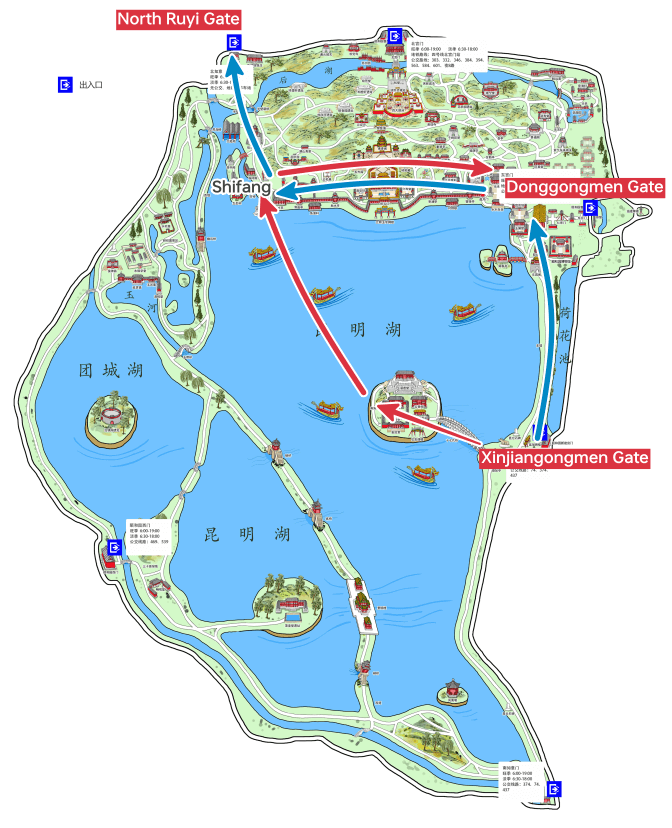
Official Site: summerpalace-china.com
Watch: BEST PARK in BEIJING 🇨🇳 The Summer Palace
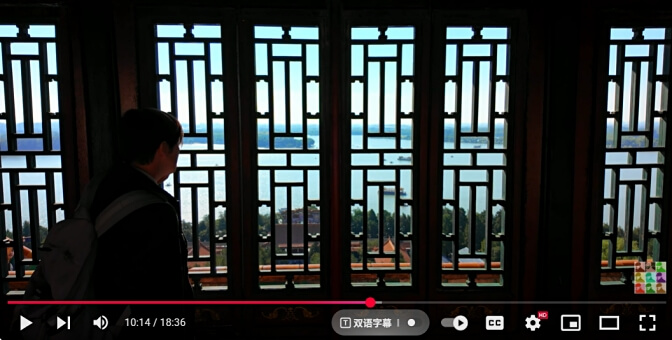
Photo Highlights:
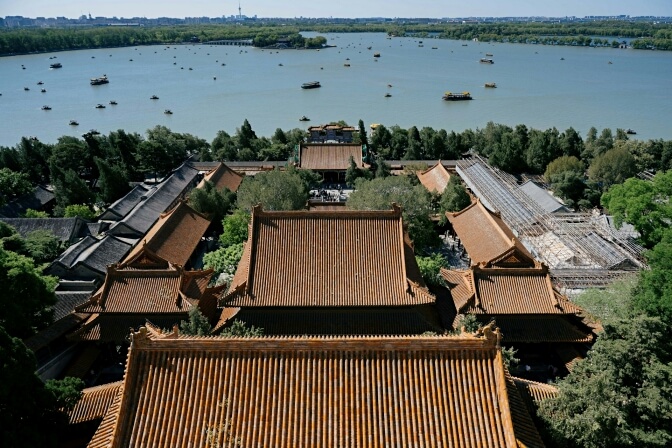
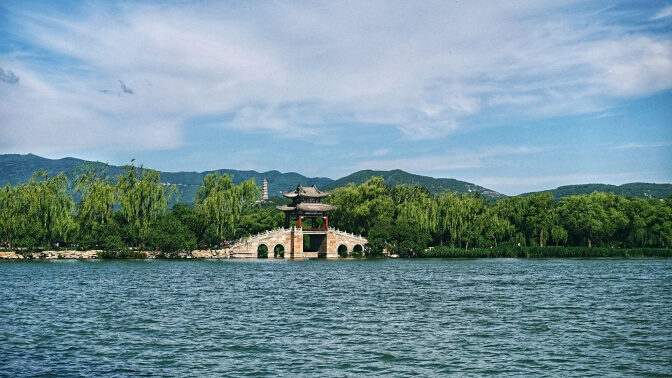
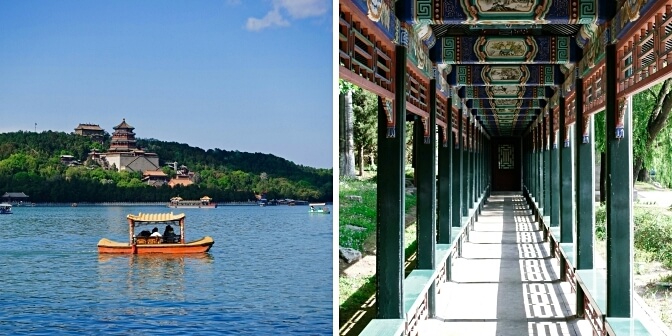 by Zikang Zhou | Nakaharu Line
by Zikang Zhou | Nakaharu Line
9. Wangfujing Shopping Street
If you want to experience “Old Beijing,” head to Qianmen Street. If you’re looking for a glamorous commercial district, Shanghai or Tokyo might be better options. Although Wangfujing is famous and often packed with tourists, the streetscape is quite ordinary—it’s just a regular shopping, dining, and movie-going area for locals.
Photo Highlights:

Main shopping centers along the street:
- Xiyue Shopping Mall:Popular with younger crowds. B2 has an anime and gaming zone (cosplay is common). B1 offers food, including bottled douzhi (Yin San) and zhajiangmian (Fangzhuang 69). These small stalls are tasty, affordable, and usually have lines.
- Oriental Plaza:A standard mall, popular with locals for its cinema and restaurants. Fewer tourists.
- Beijing Department Store:China’s first department store. B2 features “和平菓局” a 1980s Beijing nostalgia zone, and a large Hamleys toy store.
- APM:A typical modern mall with a large Apple Store.
- Yintai in88:Across from APM. The first floor has Huawei’s flagship store (a major Apple competitor). Youth-oriented, compact, and less touristy.
- WF Central: A quieter, luxury-focused mall—good for high-end dining.
Note: The Donghuamen Night Market (famous for fried scorpions) closed years ago, despite what some outdated blogs might say!
Getting There: Take Subway Line 8 to Wangfujing Station. Use Exit E1
Watch(Xiyue): 二次元探店日记-北京王府井喜悦
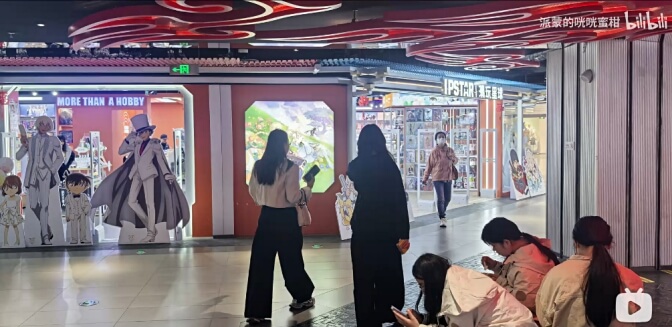
Watch(和平菓局): 3分钟带你逛完王府井的和平菓局

Watch(WF Central): 王府中环:高端购物与艺术展览融合
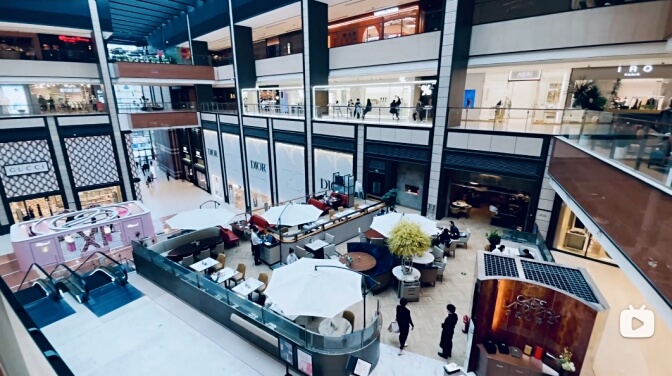
10. Yonghegong Lama Temple
Built in 1694, this is one of the most famous Tibetan Buddhist temples in Beijing. It mainly enshrines the Four Heavenly Kings (guardian deities from Indian Buddhism) and Maitreya Buddha (the future Buddha).
Buddhism has three major branches: Han Buddhism (mainly practiced in China, Japan, and Korea), Tibetan Buddhism (in Tibet, Mongolia, Nepal, etc.), and Theravāda Buddhism (in Thailand, Myanmar, and other Southeast Asian countries). Tibetan Buddhism is often seen as the most mysterious due to its complex rituals, symbolic mandalas, and the tulku system—where high lamas are believed to reincarnate.
Hours: April 1–Oct 31, 9:00 AM–4:00 PM; Nov 1–Mar 31, 9:00 AM–4:30 PM
Admission: ¥25 for adults; ¥12 for students (age 6–18) and seniors (60+). Tickets are available on-site or on Klook.
Getting There:
Take Subway Line 2 or Line 5 to Yonghegong Lama Temple Station. Use Exit F and walk about 200 meters.
Recommended Visit Time: Around 1 hour
Visiting Tips:
- You’re welcome to visit even if you don’t plan to worship.
- Free incense is provided, but it can only be lit and placed in the burners outside the halls.
- Avoid visiting during the Spring Festival—it’s extremely crowded.
A Curious Urban Legend:
Yonghegong is the most visited temple in Beijing, partly due to a viral urban legend on Chinese social media. Many people claim their wishes made here come true—though some say they were granted in strange and unexpected ways. For example, someone wished for a less stressful job and got laid off. Another prayed for a higher salary but ended up with endless overtime. One person even wished to get rich quickly—and did, after a car accident and a large compensation. Locals now jokingly call it the “literal genie effect” and often add disclaimers when making wishes, such as: “If this wish is too hard to grant, please don’t force it in a weird way!”
Official Site: yonghegong.cn
Watch: Yonghegong Lama Temple 🇨🇳
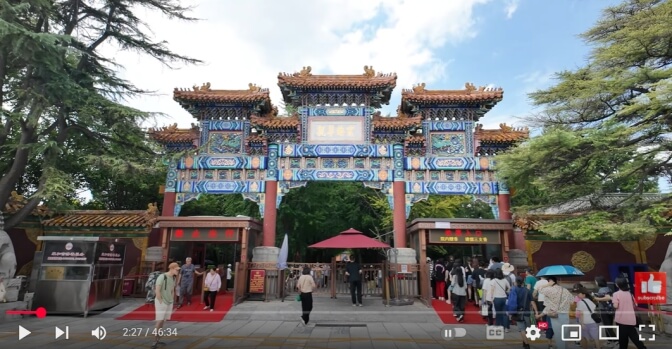
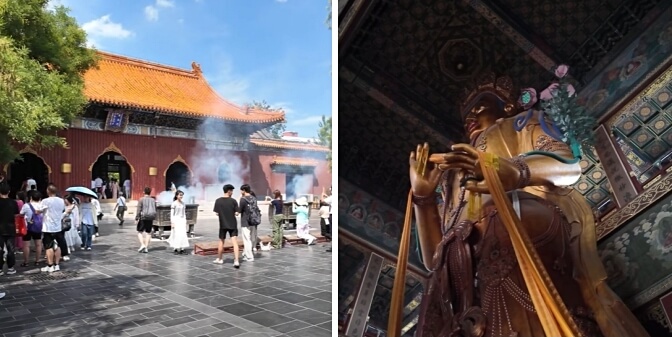
11. Popland Theme Park
The world’s only Pop Mart theme park. It’s fairly small and best suited for dedicated fans.
Hours: 10:00 AM–10:00 PM
Admission: ¥88 on weekdays, ¥119 on weekends and holidays; free for children under 1 meter. Tickets are available on-site or on Klook.
Getting There:
Take Subway Line 14 to Zaoying Station. Use Exit D and walk about 5 minutes.
Recommended Visit Time: 1-2 hours
Visiting Tips:
- Kids can enjoy slides, trampolines, and other play areas.
- Adults can take photos, try free mini-games, and attend daily character meet-and-greets with live shows.
- B1 has an exhibition of the toy production process.
- The first-floor store sells exclusive blind boxes.
- The third-floor café offers waffles (¥38) and Molly-shaped cakes (¥58).
- Birthday guests can get a commemorative badge anytime during their birth month.
Watch: Labubu Sold Out Everywhere — But I Found Beijing’s POP MART Theme Park


12. Universal Studios Beijing
Universal Studios Beijing is the third Universal Studios park in Asia and is still expanding, with only the first phase open. Unique attractions include the Decepticoaster and Jurassic World Adventure. Since it has fewer rides than the parks in Los Angeles and Osaka, it’s recommended as an optional visit rather than a must-see.
Hours: See the park schedule for details.
Admission:Around 500 RMB, depending on the specific date, Book Tickets on Klook
Recommended Visit Time: 1 day
Park Maps: Universal Studios Beijing Map
Official Site: universalbeijingresort.com
Getting There:
- Universal Studios is about 30 km (19 miles) from downtown Beijing.
- Taking a Didi ride takes about 50 minutes and costs around 70 RMB.
- By subway, it takes about 1 hour and costs around 6 RMB. Take Line 7 or Line 1 (Batong Line) to Universal Resort Station (环球度假区站). Exit at Exit B and walk about 5 minutes.
- The park can be very crowded during July, August, and Chinese public holidays. It’s best to avoid these times or buy an Express Pass. On regular days, Saturdays and Mondays tend to be busier, while Tuesdays to Thursdays and Sundays are less crowded.
- Download the Universal Beijing Resort ap to check wait times and show schedules.
Watch: Universal Studios Beijing Review & Overview: The World’s Best

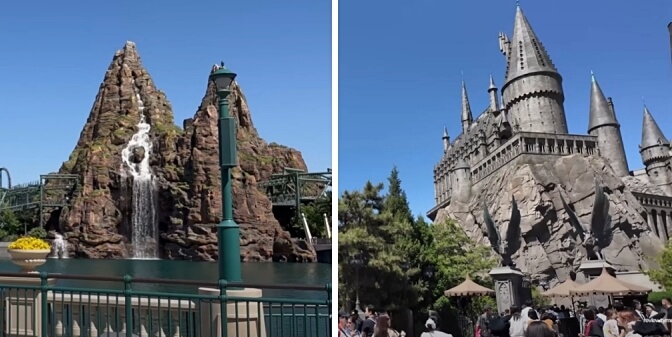
Preparation Before Traveling to China
Installing Alipay
Install Alipay before your departure (a Chinese phone number is not required) and complete all verification and activation. Alipay is often thought of as an electronic wallet, but it’s actually a super app that also lets you translate, book rides, reserve hotels, and more. You can find many videos on YouTube explaining how to use it.
Additionally, you should also consider installing WeChat. It’s the messaging app used by everyone in China and also supports payments, bookings, and other functions.
Most merchants support both Alipay and WeChat Pay, and there is no difference between the two in terms of payment functionality and methods.
Watch: How to set up and use Alipay as a foreigner in China
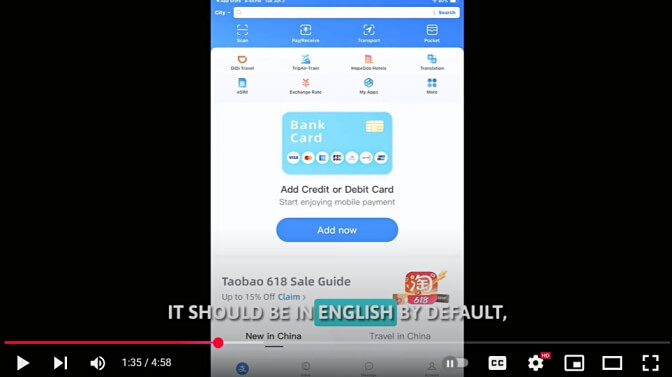
Watch: How People Pay in China: No Cash, Just Scan?

Q: Can you still use cash in China?
Yes, you can still use cash in China, but it is mainly used by elderly people who don’t use mobile phones. Cash is accepted in shopping malls, larger supermarkets, and many restaurants. However, in smaller restaurants and shops, owners may not have enough change.
Q: What if my phone runs out of battery?
Shopping malls and street-side restaurants often offer paid power banks (which come with charging cables for different types of phones). If your phone dies, you can use the power bank to give it just enough power to turn it on, then pay afterward. If you have your own charger, you can ask to charge your phone in a café or tea shop, and order a drink if they allow it. If your phone runs out of battery on the subway, visit the staffed ticket counter – they provide free charging services.
Buying an eSIM Card
You should purchase an eSIM from Nomad or Airalo to ensure internet access as soon as you land at a Chinese airport. The eSIM can be used for Alipay and booking rides through Didi. However, the downside of an eSIM is that its speed is slower, and it cannot make calls or receive SMS, meaning you won’t be able to use apps that require SMS verification, like Meituan (similar to Uber Eats).
If your budget allows or if you’re staying in China for an extended period, consider buying a Chinese SIM card at the airport in cities like Beijing or Shanghai (priced around 100-200 RMB). The internet speed will be much faster, and with a Chinese phone number, you’ll have access to all Chinese apps.
Thank you for reading, and may you have a wonderful journey!
ヽ(´▽`)/